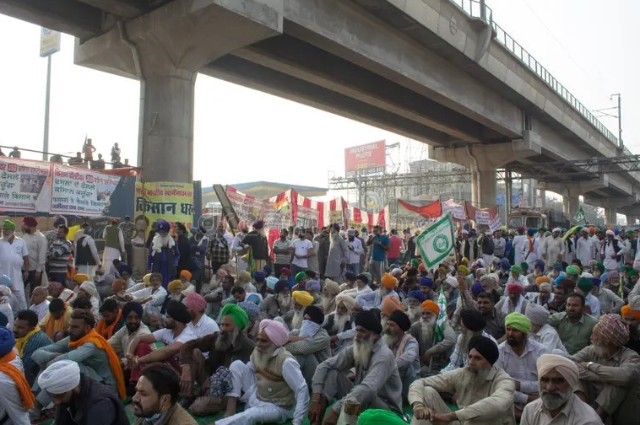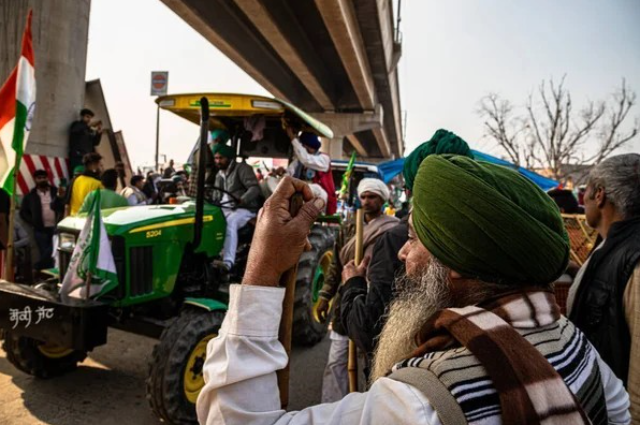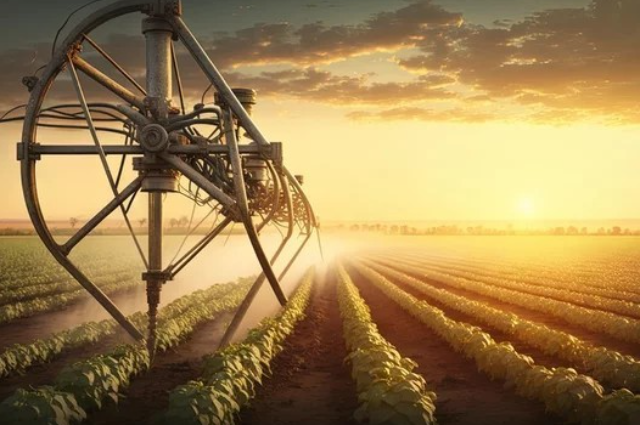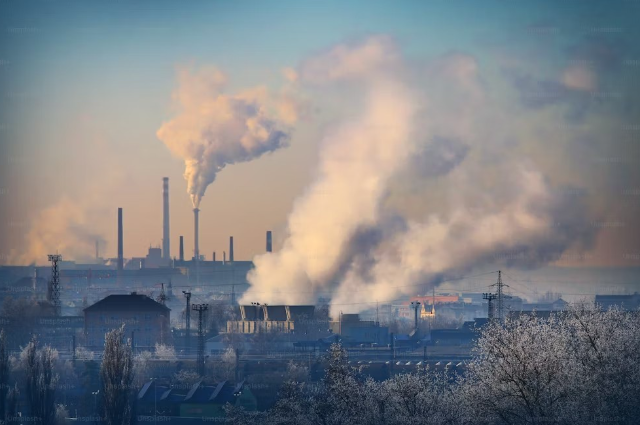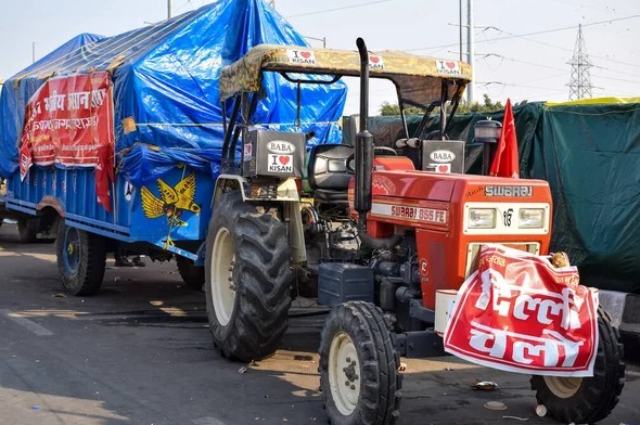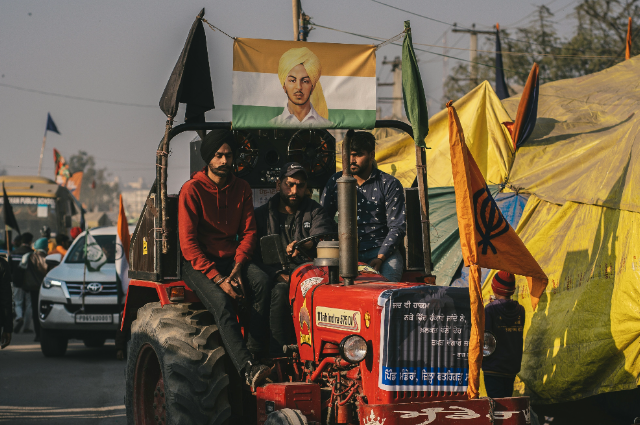
Introduction
A large contingent of farmers numbering in the thousands is currently on route to New Delhi, the capital of India utilizing tractors and trucks as their mode of transportation. Their primary objective is to compel the government to address various grievances they have which include demands such as ensuring fixed prices for their agricultural produce and offering relief from debt burdens.
In recent developments, the police in Haryana state which shares a border with Delhi resorted to using tear gas against the farmers in an attempt to halt their progression towards the capital. This action has heightened tensions in the region, significant of the extensive protests staged by farmers over a year ago. Security measures in Delhi have been significantly intensified with multiple entry points to the city being fortified using barriers made of barbed wire, spikes, and cement blocks.
In anticipation of the approaching march to Delhi organized by farmers primarily from Punjab and Haryana, as well as from other northern states, authorities have taken proactive measures. These include imposing restrictions on large gatherings within the capital and implementing internet service suspensions in various districts of Haryana.
The current protests by farmers have suggested memories of the extensive agitation that took place from 2020 to 2021, during which large numbers of farmers set up camps at various locations around the borders of Delhi. At that time, the farmers were heatedly demanding the repeal of three farm laws passed by the central government which they believed were harmful to the interests of the farming community. These laws were the Farmers’ Produce Trade and Commerce (Promotion and Facilitation) Act, the Essential Commodities (Amendment) Act, and the Farmers (Empowerment and Protection) Agreement on Price Assurance and Farm Services Act. Ultimately in 2021, the central government decided to retract these laws in response to the persistent protests. One of the primary demands made by the farmers during this period was the assurance of Minimum Support Price (MSP) for their crops.
Background
The significant demonstrations carried out by Indian farmers in 2020 and 2021 represented a crucial moment in the country's social movements. These protests were sparked by the rapid enactment of three agricultural laws by the Union government in September 2020. Due to the extensive implications of these laws and the absence of broad discussions or consultations beforehand, farmers' unions and rural movements nationwide reacted strongly. In November 2020, when the protesting farmers were barred from entering New Delhi, they established camps at the city's borders—specifically at Singhu, Tikri, and Ghazipur—where they remained for over a year. This extended deployment eventually compelled the government to withdraw the three laws in November 2021. By this time, the Kisan Andolan (farmers' agitation) had transformed into a broader movement calling for decisive government action to tackle India's systemic agrarian crisis and safeguard rural livelihoods.
Kisan Andolan and the organized protest
The Kisan Andolan alongside its well-organized protests effectively influenced the broader narratives surrounding the movement. It countered widespread misinformation spread by pro-government media outlets by actively engaging on social media platforms. Participants regularly updated urban audiences including parts of the Indian movement and international supporters about the protests. This engagement led to solidarity protests worldwide. The mobilization efforts were extensively documented including through publications like the Trolley Times and Karti Dharti, showcasing diverse perspectives and languages. The success of the farmers' protests was significant in the context of the Indian government's attempts to liberalize the economy under the environment of the COVID-19 pandemic. The repeal of the laws marked a notable retreat by an authoritarian regime which typically suppresses opposition.
The Kisan Andolan's success demonstrates strategies for countering government tactics of questioning social movements and censoring dissent. The solidarity among rural and urban communities during the protests has set new expectations for broader political struggles. This analysis delves into the alliances formed during the Kisan Andolan highlighting their remarkable success and providing insights applicable to progressive movements worldwide facing oppression, strictness, militarism, and potential global food crises.
3 farms laws that dealt with India's agricultural markets
The three farm laws that have now been repealed aimed to significantly change the way India's agricultural markets operate and are regulated.
- The Farmers’ Produce Trade and Commerce (Promotion and Facilitation) Act allowed for the sale of agricultural goods beyond the limits of Agricultural Produce Market Committees (APMCs) which traditionally safeguarded sellers' interests and ensured fair prices. The new trading venues proposed in this law would have operated without direct fault from state and local authorities.
- The Farmers’ (Empowerment and Protection) Agreement on Price Assurance and Farm Services Act introduced mechanisms to determine prices and resolve disputes in contractual farming agreements between farmers and buyers of agricultural products.
- The Essential Commodities (Amendment) Act amended the existing Essential Commodities Act (ECA), restricting the circumstances under which the government could intervene to control sharp price rises in essential food items.
Timeline of agricultural politics and historical paradigm changes
Mid 1960s - 1970s: The ‘Green Revolution’ era
The Green Revolution, also known as the Third Agricultural Revolution marked a significant period characterized by the adoption of technology transfer initiatives aimed at achieving substantially increased crop yields. This transformative phase in agriculture originated in developed nations during the early 20th century and gradually expanded worldwide until the late 1980s.
During the late 1960s, farmers started integrating various new technologies into their agricultural practices. This included the adoption of high-yielding varieties of cereals, notably dwarf wheat and rice, which played a pivotal role in boosting crop productivity. Additionally, there was widespread utilization of chemical fertilizers to support the growth of these high-yielding crops. It's worth noting that the new seeds introduced during this period required significantly higher amounts of fertilizer compared to traditional varieties to achieve their maximum yield potential. Furthermore, farmers also embraced the use of pesticides and implemented controlled irrigation practices as part of the technological advancements aimed at enhancing agricultural output.
Late 1970s to early 1990s: New farmers Movements
During the 1980s, protests led by prosperous farmers in India became a significant political entity, ultimately influencing the outcome of the 1989 elections by contributing to the downfall of the Congress government. These protests were organised by prosperous farmers belonging to dominant caste groups who had benefited from the Green Revolution. Originating from the farmers' movements of the 1970s and 1980s, these demonstrations were instrumental in advocating for the economic interests of these rich agriculturalists, thereby leaving a lasting impact on Indian national politics. Despite the initial prosperity brought about by the Green Revolution the implementation of neoliberal economic policies left these farmers economically dangerous, affecting rural communities across various caste and class boundaries. Consequently, this led to a rise in rural economic disparities and exacerbated existing class divisions.
Early 1990s onward policies
India's adoption of neoliberal reforms promotes the expansion of corporate-controlled large-scale industrial farming. This shift poses a threat to various local food systems and has the potential to worsen existing issues or even generate new ones including raised food prices, increased poverty among farmers, loss of biodiversity, and decreased flexibility to climate change.
The 1990s and the global level trade initiatives
The Uruguay Round Agreement on Agriculture (URAA) marked a significant milestone in the transformation of the agricultural trade framework. It introduced regulations aimed at curbing trade-distorting domestic policies and implemented fresh guidelines concerning market access and export competition.
June 5, 2020 - September 27, 2020: Introduction and Passing of Farm Bills
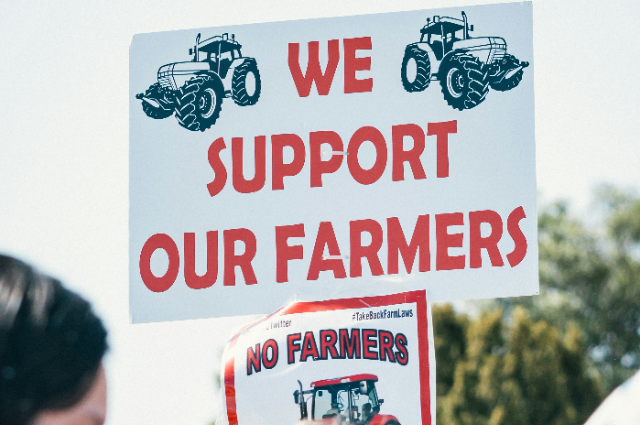
Photo by Gayatri Malhotra on Unsplash
On June 5, 2020, the government introduced three farm bills. Following this, an ordinance was brought to Parliament on September 14, 2020, and subsequently passed in the Rajya Sabha by voice vote on September 20, 2020. The Shiromani Akali Dal (SAD) exited the BJP-led National Democratic Alliance over the farm bills on September 26, 2020. Finally, on September 27, 2020, the farm bills received presidential assent and became farm laws.
November 25, 2020 - January 29, 2021: Escalation of Protests and Government Response
Farmers' unions in Punjab and Haryana called for a 'Delhi Chalo' movement on November 25, 2020, leading to confrontations with police on November 26, 2020. Despite offers for talks, including one from Union Home Minister Amit Shah on November 28, 2020, and subsequent meetings on December 3, 2020, and December 5, 2020, no resolution was reached. The deadlock persisted as farmer leaders rejected the government's proposal to amend the laws on December 9, 2020. The Bharatiya Kisan Union (BKU) moved the Supreme Court against the laws on December 11, 2020.
January 7, 2021 - March 8, 2021: Supreme Court Intervention and Continued Protests
The Supreme Court agreed to hear petitions challenging the laws and those against the protests on January 7, 2021. On January 12, 2021, the court stayed the implementation of the farm laws and formed a committee to make recommendations. However, clashes between protestors and police on Republic Day, January 26, 2021, escalated tensions. Despite the government's proposal to suspend the laws for one-and-half years on January 29, 2021, protests continued, culminating in a nationwide 'Chakka Jam' on February 6, 2021.
April 15, 2021 - November 19, 2021: Political Developments and Repeal of Farm Laws
Political efforts, including Haryana Deputy CM Dushyant Chautala's letter to Prime Minister Narendra Modi on April 15, 2021, urging talks with farmers to continue. The agitation marked significant milestones such as observing a 'black day' on May 27, 2021, and observing Sampoorn Krantikari Diwas (total revolution day) on June 5, 2021. Finally, on November 19, 2021, Prime Minister Narendra Modi announced the repeal of the farm laws signaling a significant development in the prolonged agitation by farmers.
What's exactly the reason for North farmers protesting while their counterparts in the southern regions do not?
Two sides of the same coin but different responses and approaches
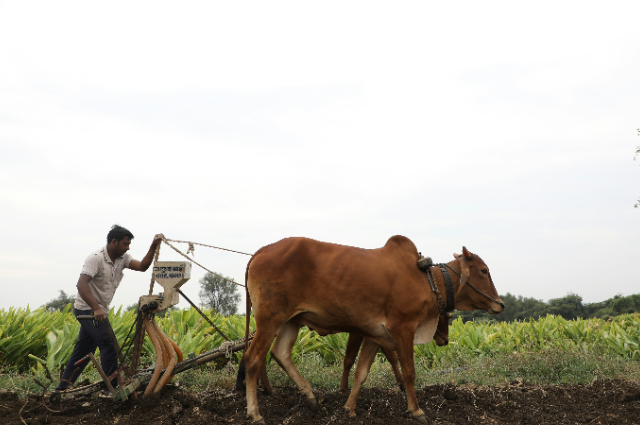
Photo by amol sonar on Unsplash
As the farmers' protests resurface in Delhi, there's a significant disparity in perspectives between the protesters and policymakers. Policymakers, across different governments tend to view farmers' demands solely through an economic lens favoring market-driven pricing mechanisms.
However, for farmers, their demands stem from the deep-rooted challenges they confront due to various transformations in their livelihoods. Despite governments and experts relying on economic theories to address farmers' concerns, there's a risk of neglecting the broader implications for India's food security.
Understanding the farmers' protests requires considering key transformations
- Income Disparities: Agriculture's diminishing contribution to GDP contrasts sharply with the rapid growth of non-agricultural sectors globally. Even if agricultural productivity were to improve it wouldn't match the income growth seen in sectors like information technology. Consequently, farmers aspire to income equivalence with these sectors reflecting their changing consumption patterns.
- Aspirational Divide: The response to farmers' aspirations is shaped by the legacy of the Green Revolution which disproportionately benefited irrigated areas over dry land regions. This led to a stark disparity between regions with irrigated areas experiencing higher productivity and economic growth. As a result, farmers in Green Revolution regions demand greater returns from agriculture to meet their heightened aspirations while those in less favoured regions seek opportunities outside agriculture.
In essence, the ongoing farmers' protests are predominantly driven by regions that thrived during the Green Revolution where aspirations for improved livelihoods collide with the limitations of agriculture. Meanwhile, regions that were left behind by the Green Revolution have shifted their focus away from agriculture resulting in a varied landscape of protest participation.
Global warming and Climate change
Punjab's prominent involvement in these protests stems from a third significant shift: the global repercussions of climate change. With global warming projected to decrease occurrences across vast regions of the northern hemisphere, there's an accompanying rise in agricultural potential. A Government of Canada source highlights the prospect of cultivating warmer climate crops due to extended growing seasons and fewer extreme cold spells. This trend arguably plays a role in Canada's increasing accessibility to immigration from farming communities. Given Punjab's history of showcasing agricultural expertise during the Green Revolution, its farmers become an evident demographic of interest. Moreover, their aspirations are influenced by the economic achievements of acquaintances and relatives who have migrated to Canada.
Markets have no answer
Economists advocate for allowing the market to determine how to address the combined effects of three significant changes. This approach though theoretically attractive and supported by mathematical models poses evident risks. The market's response to agricultural production can be unpredictable, especially considering the cyclical nature of production which can lead to fluctuating food prices. If the per capita net production of food does not increase rapidly these fluctuations may become more frequent potentially affecting stability. Additionally, expecting governments to adhere strictly to market principles, particularly regarding food prices, is unrealistic, especially in economies where distributing free food to a large portion of the population is common practice.
Despite the preferences of market-friendly economists, governments often intervene during price spikes by restricting exports to meet immediate needs and prevent food crises. However, this short-term approach can strain relations with farmers. Given that market-driven policies are impractical in the context of providing food security for millions, the focus should be on ensuring long-term food security while acknowledging the reality of free food distribution. Agricultural policies should aim to meet the needs of both the subsidized population and the rest of society by prioritizing sufficient food production ideally from the most productive lands.
Less-developed agricultural regions
In less developed agricultural regions growth in food output may be limited as labour is drawn to more profitable sectors exacerbating food security challenges. Equally, in advanced agricultural regions, international migration may increase, further depleting the agricultural workforce. Encouraging farmers to switch to non-food crops as advised by economists could worsen this situation. While these trends may not drastically impact average food availability, their implications for food security are complex and require attention.
Address the challenges faced by less productive farms
To address the challenges faced by less productive farms, governments could promote the establishment of farm management cooperatives which could improve efficiency through economies of scale. Owners of such farms could explore non-agricultural employment opportunities while retaining ownership rights. Balancing the long-term goal of food security with the interests of individual farmers is a difficult task. Rather than simply criticizing farmers for their responses to these transformations, it's crucial to identify pragmatic solutions that support both objectives.
Farmers and Centre discussion: effects through BJP Rule
The ongoing discussions between the Centre and farmers continue amidst incidents of police intervention using tear gas and pellet guns against farmers attempting to breach barricades and hurl flaming gunny bags towards law enforcement. Analyzing the potential impact of the current "second farmers movement" in comparison to the previous one involves examining the political repercussions of the farmer protests that occurred during 2020-21.
The initial movement did manage to sway the broader political discourse, notably leading to the dissolution of the longstanding coalition between the BJP and the Akali Dal in Punjab. This rupture in alliance provided a significant boost to the opposition's political narrative, particularly emphasizing the plight of marginalized farmers versus a government perceived as pushing disruptive agricultural reforms. Despite this narrative shift, the movement failed to significantly impact the electoral prospects of the ruling party.
Although the protests had some localized electoral impact notably in certain constituencies within Uttar Pradesh's sugarcane belt during the 2022 state elections, the BJP managed to retain support from farmers overall. Surveys conducted at the time indicated that the BJP maintained a stronger hold over farming households compared to non-farming ones suggesting limited electoral repercussions from the protests.
Moreover, the movement did not herald a substantial departure from the prevailing trends of hard nationalism and religious polarization dominating Indian politics. This lack of a decisive shift can be attributed partly to the inherent divisions within the farming community itself particularly along lines of caste and class. Contradictions of interest between different agrarian groups such as dominant landowning Jats, marginalized OBC farmers, and Dalit agricultural labourers, often overshadow broader rural-urban divides in terms of political significance.
These intra-rural divisions reflect lived realities and are more intense compared to abstract urban-rural distinctions. Additionally, advancements in communication technology over the past few decades have diminished cognitive barriers between rural and urban populations blurring the traditional material distinctions between farming and non-farming livelihoods.
Concerns in Punjab persist for the NDA due to potential disruptions caused by agitation which could disrupt the improving relations between the BJP and Akali Dal. In the 2014 elections, the NDA held a significant lead of 25% over Congress among Jat Sikhs in Punjab but by 2019, Congress had narrowed this lead. Currently, both Congress and AAP are leading ahead of the former NDA coalition not only among Jat Sikhs but also among the wider population. Even if the NDA fails to secure any seats in Punjab, the impact would only be a loss of six seats.
On the other hand, Haryana and UP are crucial states for the NDA. In both states, the NDA has formed coalitions with prominent political parties representing the Jat farming community: JJP in Haryana and RLD in UP. As long as these allies remain influential, the NDA's electoral prospects in these states remain stable. The BJP's core support base in both regions consists of upper castes, OBCs, and a significant welfare constituency mobilized through various government initiatives.
However, the BJP's concern lies in whether the prolonged farmer protests could shape a negative political narrative suggestive of previous movements, especially with the general election forthcoming. Recent surveys indicate some vulnerability for the NDA, with a majority of respondents believing that big businesses rather than farmers or daily wage earners have benefited the most from government policies. Additionally, a significant portion of the population feels that the government's economic policies have widened the gap between the rich and the poor.
Despite these concerns, the current farmer protests seem less likely to gain traction compared to the 2021 movement. This time, farm unions are divided lacking clear objectives and major factions have distanced themselves. Moreover, there isn't a clear narrative against big businesses, making it challenging to rally public support. With other mobilizations and signs of economic recovery, the government appears to be more stable.
While the 2020-21 farmer protests were significant politically, the current round may not have the same impact and could be overshadowed by other events as the election season approaches.
Analyzing the demands and requirements of farmers
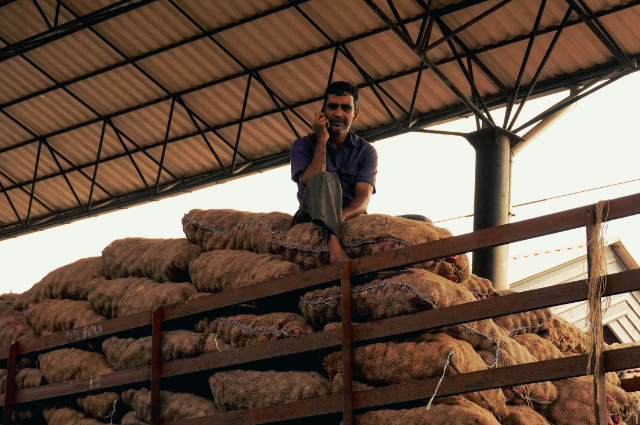
Photo by Hardik Monga on Unsplash
In 2024, the farmers' protest revolves around several key demands:
- Minimum Support Price (MSP) Guarantee: Farmers are calling for a law that would ensure a guaranteed minimum price for all crops. This legal framework aims to safeguard farmers' income levels and bring stability to agricultural markets by providing them with a reliable floor price for their produce.
- Debt Waiver: There is a push for the implementation of the Swaminathan Commission’s recommendations which include providing debt waivers to farmers. Specifically, the demand is to waive all debts exceeding Rs. 10,000 amounting to ₹18.4 lakh crore. This measure aims to alleviate the financial burden on farmers and address the issue of increasing agricultural debts.
- Land Acquisition Compensation: Farmers are seeking fair compensation for their land acquired by various authorities for development projects. Additionally, they are advocating for the reservation of 10% of residential plots on developed lands for the families affected by land acquisition. This demand aims to ensure that farmers are adequately compensated for their land and that the adverse effects of land acquisition on affected families are mitigated by providing them with housing opportunities.
- International trade agreements and WTO - Some farmers are apprehensive about how international trade agreements could affect their livelihoods. They advocate for India's withdrawal from the World Trade Organization (WTO) and the prohibition of all Free Trade Agreements (FTA) to address these concerns. Their goal is to protect their interests from potentially negative impacts of global trade agreements.
- Justice for Lakhmipur Violence - Furthermore, the farmers are demanding justice for the victims of the Lakhimpur Kheri violence where several farmers tragically lost their lives. They seek punishment for those responsible for the massacre emphasizing the importance of accountability and closure for the affected families.
- Provision of pension benefits - Additionally, a key demand is the provision of pension benefits for both farmers and farm labourers. This initiative aims to recognize the contribution of these individuals to the agricultural sector and ensure their financial security in old age.
The farmers are advocating for several specific measures:
- MGNREGA Employment: They are pushing for 200 days of employment annually under the Mahatma Gandhi National Rural Employment Guarantee Act (MGNREGA) specifically for farming activities. This initiative aims to provide consistent income opportunities for rural workers. Additionally, they stress the importance of a daily wage of Rs 700 to adequately support these workers financially.
- National Commission for Spices: There is a call for the establishment of a commission dedicated to addressing the unique challenges faced by spice growers. This commission would focus on developing strategies and policies tailored to the spice industry's needs, aiming to support and enhance the livelihoods of spice farmers.
- Protection of Indigenous People’s Rights: The farmers are advocating for the protection of land, forests, and water sources that belong to tribal communities. They emphasize the importance of upholding the rights of indigenous people and ensuring that their resources are safeguarded against exploitation or encroachment.
- Improving Seed Quality: Farmers are urging for measures to improve the quality of seeds. They propose penalties for companies that produce forged seeds, pesticides, and fertilizers, as these can negatively impact agricultural productivity. This initiative aims to ensure that farmers have access to high-quality inputs for their crops, ultimately leading to better yields and agricultural sustainability.
Certainly, here's a detailed explanation of the provided text:
1. Financial Security:
- Guaranteed Income: Farmers aged 60 and above are demanding a monthly pension of ₹10,000 to ensure financial security during their retirement years.
- Minimum Wages under MGNREGA: Protesters are advocating for fixed daily wages of ₹700 for agricultural work under the Mahatma Gandhi National Rural Employment Guarantee Act (MGNREGA), with a guarantee of 200 days of work annually. This measure aims to provide stable income opportunities for rural workers.
2. Agro-Industry Integration:
- Farmers are pushing for closer integration with the agro-industry to bypass intermediaries and gain direct market access. They propose establishing farmer-producer organizations to collectively bargain for fair pricing, reduce dependency on middlemen, and ensure better market access.
3. Market Support:
- Legal Guarantee of Minimum Support Price (MSP) for All Crops: The central demand of the protest is the enactment of a legal framework guaranteeing Minimum Support Price (MSP) for all agricultural produce. Currently, MSP is announced only for certain crops, leaving others susceptible to market fluctuations. A legal guarantee would offer farmers more stability and predictability in their income.
- Implementation of Swaminathan Committee Recommendations: Protestors are calling for the implementation of recommendations from the M.S. Swaminathan Committee, established in 2006 to address agricultural issues. The committee's proposals include enhancing infrastructure, investing in research and development, and implementing market reforms to improve farmers' income and overall welfare.
Central Government quotes farms produce data on crops
The recent discussions between the Central government and protesting farmers from Punjab and Haryana have led to the sharing of data by government sources. This data highlights the significant benefits received by farmers in both states over the past decade due to increased procurement of paddy and wheat at minimum support prices (MSP), as well as through various farm schemes under the NDA government compared to the preceding ten years when the UPA was in power.
According to the data compiled from various ministries the total procurement of paddy in Punjab during the UPA regime (2004-05 to 2013-14) was 1,263 lakh metric tonnes (LMT), which rose to 1,686 LMT during the NDA government (2014-15 to 2023-24), marking a 33% increase over the decade. This increase has benefited approximately 94 lakh farmers in the state. Similarly, wheat procurement in Punjab increased from 975 LMT to 1,176 LMT during the same period, benefiting nearly 70 lakh farmers. In terms of value, there was a 157% increase in paddy procurement and a 110% increase in wheat procurement in the state.
In Haryana, the data also reflects a similar trend. The total procurement of paddy increased from 284 LMT during the UPA era to 539 LMT during the NDA period. Additionally, wheat procurement in Haryana rose from 552 LMT to 719 LMT during the same period.
The government sources aim to convey a message to the protesting farmers that the NDA government has consistently raised MSP and procurement to ensure benefits for producers. Punjab and Haryana have traditionally been major contributors to procurement in the country, driven by government efforts in these states.
The latest 4th round of talks of ‘Delhi Chalo ’ protest continues
Union Ministers Arjun Munda, Piyush Goyal, and Nityanand Rai assembled with farmer leaders in Chandigarh for the fourth round of talks to address the continuing farmers' protest.
Insiders suggest that discussions between the government and farmers have shown signs of progress, despite previous meetings on February 8, 12, and 15 ending without reaching a definitive resolution.
In the meeting, the government aimed to reach an agreement on three pivotal matters: securing the Minimum Support Price (MSP) assurance, executing suggestions from the Swaminathan Commission, and offering debt relief to farmers, as per sources.
The mainstream farmer unions are contemplating joining the ongoing farmers' protest. Leaders from the Samyukt Kisan Morcha (Political), including Balbir Singh Rajewal (BKU Rajewal) and Harinder Singh Lakhowal (BKU Lakhowal), are scheduled to convene a meeting in Ludhiana to plan their course of action. Their agenda encompasses discussions on potential involvement in the 'Delhi Chalo' March and protests at toll plazas if their demands are not addressed.
While the SKM (Political) faction has refrained from staging protests thus far, Joginder Singh Ugrahan, the chief of BKU (Ekta Ugrahan) – the largest farmer union in Punjab, remains hesitant about participating in the march. Presently, Ugrahan's group is actively protesting outside the residences of former Punjab Chief Minister Captain Amarinder Singh, BJP chief Sunil Jakhar, and others.
Recent developments in the ongoing farmers' agitation
- Various farmer unions nationwide, including the Bhartiya Kisan Union (Charuni) and BKU leader Rakesh Tikait, have expressed solidarity and announced plans for further demonstrations, including a possible tractor march to Delhi if their demands are not met. To intensify their protest, farmers are set to hold dharnas in Uttar Pradesh, Haryana, Punjab, and Uttarakhand on February 21, as stated by Tikait.
- Gurnam Singh Charuni, leader of the Bhartiya Kisan Union (Charuni), disclosed plans for a 'Mahapanchayat' at Kurukshetra, where farm organizations, labour groups, and village council heads will discuss their next steps in supporting the ongoing farmers' protests.
- The farmers' movement is gaining momentum nationwide. Over the weekend, protesting farmers organized a tractor march in Haryana and staged dharnas outside the homes of senior BJP leaders. Moreover, about 100 farmers were arrested during a 'rail roko' protest in Tamil Nadu's Thanjavur.
- In response to the protests, the Haryana government has extended the ban on mobile internet and bulk SMS services in seven districts until February 19 to maintain public order.
- In certain areas of Punjab, including Patiala, Sangrur, and Fatehgarh Sahib, internet services have been suspended until February 24, following orders from the Union Ministry of Home Affairs, due to the 'Delhi Chalo' march by the farmers.
- The farmers' camp at the Shambhu and Khanauri border points between Punjab and Haryana following the uncertain of their 'Delhi Chalo' protest march by security personnel.
The protesting farmers are demanding not only a legal assurance of Minimum Support Price (MSP) but also the implementation of the Swaminathan Commission's recommendations, pension schemes for farmers and labourers, debt waivers, no rise in electricity tariffs, withdrawal of police cases, justice for the victims of the Lakhimpur Kheri violence, reinstatement of the Land Acquisition Act, 2013, and compensation for families affected by the 2020-21 agitation.
Conclusion
After discussions between government officials and farmer leaders there's a suggestion to implement a 5-year plan aimed at purchasing pulses and maize at a Minimum Support Price (MSP). MSP acts as a safety net created by the government to ensure farmers receive a fixed price for their produce protecting them from market fluctuations. Recognizing the significance of pulses and maize in agriculture the government's proposal aims to provide consistent support by guaranteeing farmers a stable income.
According to the plan, a set amount of pulses and maize will be bought at MSP for the next five years. This initiative is crucial for maintaining price consistency preventing the exploitation of farmers by middlemen and promoting sustainable agriculture. By creating a reliable market and fair pricing mechanism the plan aims to encourage farmers to continue growing these crops, thereby enhancing the nation's food security efforts.
. . .
References:
- https://www.reuters.com/world/india/
- https://www.hindustantimes.com/india-news
- https://m.economictimes.com/news/economy
- https://www.thehindu.com/news/national
- https://timesofindia.indiatimes.com/india
- https://www.hindustantimes.com/india-news
- https://m.economictimes.com
- https://newsonly.vedasinnovation.com
- https://m.economictimes.com/opinion
- https://www.indiatoday.in/india/story
- https://m.economictimes.com/news

